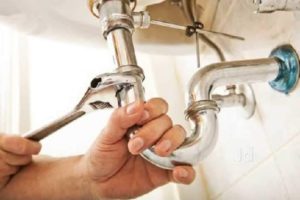A homeowner’s worst nightmare can be a burst pipe, leading to sudden chaos and the potential for water damage. Prompt action is crucial to limit damage and ensure safety, whether triggered by freezing temperatures, corrosion, or other factors. This piece offers crucial advice on handling emergency repairs to address the situation until assistance from a professional is available.
Turn off the water supply:
Addressing a burst pipe begins by turning off the primary water source for your residence. Identify the main shut-off valve adjacent to the water meter and rotate it clockwise to cease the water supply. This action prevents further water from gushing out of the burst pipe, reducing the potential for extensive damage.
Empty the faucets:
Once you’ve closed the main water supply, open all faucets throughout your residence to facilitate the drainage of any remaining water from the plumbing system. This helps alleviate pressure within the pipes and reduces the likelihood of additional leaks or bursts.
Locate the position of the burst pipe:
Locate the burst pipe once you’ve turned off the water supply and allowed the faucets to drain. Search for indications of water seepage, such as discoloured patches, swollen walls, or moist areas on ceilings or floors. Additionally, be attentive to the sound of running water, as it can assist in pinpointing the exact location of the burst pipe.
Temporary Repair Measures:
While waiting for professional assistance, it’s crucial to implement temporary repair measures to contain the situation. Depending on the severity of the burst, you can use various materials to temporarily patch the pipe, such as pipe clamps, epoxy putty, or rubber patches. Wrap the damaged area tightly with rubber or cloth, securing it with a clamp or duct tape. Implementing this interim solution can help reduce water seepage until a lasting repair can occur.
Thaw Frozen Pipes:
If freezing temperatures cause a pipe to burst, you must thaw it carefully to prevent further damage. Use gentle heat from a hair dryer, heat lamp, or space heater to thaw the frozen portion of the pipe. Avoid using open flames or high-temperature devices, which can pose a fire hazard. Check for cracks or damage once the pipe is thawed before restoring water flow.
Cleanup and Restoration:
After the burst pipe is temporarily repaired and professional assistance has been contacted, focus on cleanup and restoration efforts. Utilize a wet vacuum or mop to eliminate any standing water, thereby preventing potential water damage to walls, floors, and furniture. Use fans and dehumidifiers to thoroughly dry affected areas, thus preventing mould growth.
Preventative Measures:
To avoid future burst pipes, take preventative measures such as insulating exposed pipes, especially in cold climates, and regularly inspecting plumbing for signs of corrosion or damage. Additionally, keep cabinets under sinks open during cold weather to allow warm air to circulate pipes.
Routine Plumbing Checks:
Arrange regular evaluations of your plumbing system conducted by a certified plumber to detect potential issues before they become urgent. Professional inspections can uncover hidden leaks, corrosion, or weak spots in the pipes, allowing for timely repairs and maintenance.
Appropriate Waste Disposal:
To avoid accumulation and potential pipe blockages, do not pour grease, oil, coffee grounds, and other debris down the drains. Instead, dispose of such waste in designated containers or recycle it appropriately to prevent blockages and maintain optimal drain flow.
Use Drain Filters:
Place drain screens or filters in sinks, showers, and tubs to capture hair, food particles, and other debris before entering the drain pipes. Routinely clean and empty these screens to avoid buildup, which could lead to clogged drains and plumbing complications.
Mindful Water Usage:
Practice water conservation habits to reduce strain on your plumbing system and prevent potential leaks or bursts. Be cautious about excessive water consumption, including running faucets or showers for prolonged periods. Fix dripping faucets promptly to conserve water and alleviate pressure on the plumbing infrastructure.
Educate Household Members:
Educate everyone about proper plumbing upkeep and preventing clogged drains. Encourage responsible usage of sinks, toilets, and other plumbing fixtures, emphasizing the impact of their actions on the overall health and longevity of the plumbing system.
Conclusion:
Dealing with a burst pipe requires quick action and effective emergency repair measures to minimize water damage and ensure the safety of your home. By following these tips, you can effectively handle a burst pipe situation until professional help arrives, ultimately saving time, money, and stress in the long run. Remember to prioritize safety and consult with plumbing professionals for permanent repairs and preventative measures to safeguard your home against future incidents.



